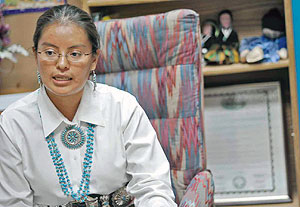An eye-opening year for outgoing Miss Navajo Nation
By Chee Brossy
Navajo Times

(Times photo - Donovan Quintero)
Miss Navajo Jonathea Tso speaks about her year as the Navajo Nation's ambassador Friday at her office in Window Rock.
As her reign winds down, Miss Navajo Nation Jonathea Tso is still busy.
On Saturday night she will relinquish her crown to a new Miss Navajo. At her office recently Tso reflected on her time as the Navajo Nation's ambassador.
Her reign opened her eyes to the vastness of Dinétah, she said.
Growing up in Cove, Ariz., and going to high school in Aztec, N.M., most of her time was spent on the northeastern part of the reservation so being able to travel as Miss Navajo left a great impression on her.
She had never been to the Ramah or Alamo satellite reservations and was surprised to find the communities there - but also a little embarrassed that she had not known more about them.
"Ramah Police Department has its own uniforms, different from here on the larger reservation," she observed. "And I didn't know how far Alamo was from us. It's about as far as Albuquerque. Seeing these places for the first time also helped me realize that I wasn't really aware of all the issues facing people across the reservation."
One of those issues she came face to face with was the struggle of the relocatees from the Navajo-Hopi land dispute.
"I see my job as all about encouragement, giving that to the people I meet," she said. "And as Navajos we say that land is our identity. I couldn't imagine leaving home like the relocatees had to. It was hard finding words of encouragement for them when I went there."
Throughout her reign Tso, 26, emphasized to youth the importance of learning Navajo tradition and culture. She would often tell the story of the adééstsiin, or Navajo stirring sticks, which are a form of protection as well as a practical tool.
"Today children think of weapons as guns and knives, when the adééstsiin is a woman's weapon," she said. "It's used as protection against poverty. It looks simple but there are a lot of teachings behind it. I would encourage people to ask their parents and grandparents about things like that wherever I went."
Tso is Kinlich’i'nii (Red House Clan), born for T—d’ch'’i'nii (Bitter Water Clan). Her chei is Táchii'nii (Red Running into Water Clan) and her nál’ is Nát'oh Dine'é Táchii'nii (Tobacco Division of Red Running into Water Clan).
Despite growing up in a tightly knit Navajo community and being raised by her grandmother, Tso realized upon graduation from Dartmouth College in 2004 that she still had much to learn about her culture and history.
Diné College seemed like the right choice to continue her education.
"My Diné College education helped me tremendously," she said. "I didn't know a lot about Navajo history before then. For example, if I hadn't taken those classes I would have been totally lost when I had to present at the opening of the exhibit of Naalstsoos Sán’, or the Treaty of 1868, at the (Navajo Nation) museum. Because of those classes I knew the history behind it."
After her reign is up, Tso would like to continue her education at Diné College and finish with degrees in Navajo language and Diné studies, she said.
After that she would like to pursue graduate school, although in which field she is not sure yet. She is leaning toward something involving natural resources or environmental studies.
Her undergraduate work at Dartmouth College, where she majored in Native American and environmental studies, would go a long way to preparing her for graduate work, she acknowledged.
But she also likes the idea of being a Native scholar in general, she said, without being pigeonholed into one exclusive field.
"I had a Native American studies professor at Dartmouth who, when I told him I thought I wanted to go into law, replied that the law school formula leaves many Native students disappointed," she said. "He challenged me to be a Native scholar, and there's no program out there for that, you just have to keep learning and educate yourself."
For inspiration in that direction Tso looks to Navajo poet Luci Tapahonso, who has branched out from her poetry to collaborate on music projects as well.
"I've always looked up to (Tapahonso) for her ability to write poetry in Navajo and in English," she said. "For myself, I don't know what I would write about yet, but I want to be ready when the time comes."
When asked for a parting message to the Navajo people, Tso drew from her experience speaking and relating with Navajo youth.
"I wish for our grandparents, and mothers and fathers, to share the Navajo language and culture with our youth," she said. "When kids speak the language, or try to speak the language, their parents and grandparents laugh now. They think it's cute because maybe (the kids) don't say it completely right. That's when the kids stop speaking Navajo and won't speak it again.
"I would say to the parents: 'Take them seriously,'" she said. "And to the youth: 'Respect your parents. Remember, you are wonderful, and beautiful, and magical.'"

